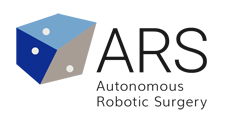ARS
about the project
official project video
Watch the project video and discover what ARS is about!
advisory board
The advisory board is convened at least once a year to discuss the progress and the plans of the ARS project.
The Advisory Board is composed of well-known scientists in the areas of robotics, machine reasoning
Prof. Alicia Casals
Professor of the Automatic Control Department at the Technical University of Catalonia.
Head of the Robotics and Vision Division of the Biomedical Engineering Research Centre (CREB).
Associate researcher of the Institute of Bioengineering of Catalonia. Info here
Prof. Pierre Jannin
Prof. Jannin is Professor at the University of Rennes. He is Research director at the National French Institute of Health and Scientific Research and President of the French International Scientific Society of Computer-assisted Surgery. Info here
Prof. Marco Zenati
Prof. Marco Zenati is a heart surgeon, and Professor of Surgery at the Harvard Medical School, Boston. Info here
State-of-the-art and
the Project Objectives
In the past ten years, service robotics has reached a level of performance and credibility that makes it appealing to the general public. Some progress has been made in introducing autonomy, however only small individual actions have been demonstrated. Because of this, commercial robots still rely on hard automation, as industrial robots, or are teleoperated as surgical and underwater robots.
The ARS project aims at making the scientific advances that will enable the autonomous execution of complete procedures in uncertain and partially unknown environments.
We have chosen robotic surgery as the domain of this research because it combines all the aspects that make the execution of complete autonomous processes a very difficult problem. In fact, it is carried out in an uncertain environment in which errors can be deadly, the environment is deformable and cannot be modeled precisely in advance, and interventions must be adapted in real time to the patient anatomy and conditions. In the ARS project we will address the execution of a full surgical intervention in all its aspects from the initial planning, to its execution and performance measures. Although this goal may seem out of reach of current robotics research, three coincidental factors give the ARS project the necessary scientific and technical edge to succeed.
These three unique factors make this project very timely and with great chances of success:
Factor 1
The encouraging results of our past project I-SUR on autonomous robotic surgical actions.
Factor 2
The availability of a large dataset of clinical robotic surgical interventions thanks to the collaboration with international clinical research centers.
Factor 3
The readiness of a da Vinci surgical robot equipped with the da Vinci Research Kit (DVRK) on which to demonstrate the results.
The slow progress of autonomous service robots is due in part to the lack of a unified theoretical framework for planning and executing autonomous tasks, especially for risky tasks.
These tasks cannot be directly programmed into the robot but must be learned from experience by examining how humans address unpredictable situations. Until now, this learning step has not been possible because of the lack of enough representative data about the task to be made autonomous. The large data set on robotic surgery that will be made available to the project will make it possible to use big data techniques to learn how humans reason and act during an intervention, and to derive corresponding planning and control procedures for the robot.
Open surgery is the classical approach to interventions, in which large incisions into the patient body allow accessing the anatomic district of interest.
Although it requires longer recovery time, this approach provides the best visibility of the intervention area and the best dexterity to operate on the patient. To avoid the large incisions and improve recovery, Minimally Invasive Surgery (MIS) was developed to reach the surgical area through small holes, called ports, by using narrow and elongated laparoscopic tools. Operating through ports is difficult because of the reduced perception and dexterity, but it subjects patients to lesser trauma.
Robotic Surgery has removed some of the difficulties of MIS by using small, articulated tools and a stereoscopic camera, thus conjugating the small size of MIS tools, with the dexterity and depth perception of open surgery.
For these reasons, robotic surgery is one of the most active and successful areas in robotics, with a significant public acceptance, exceptional economic results and an active network of research laboratories.
Surgical robots installed worldwide
surgical procedures performed
Surgical robots are teleoperated devices in which an operator, the surgeon, sits at a console, a few meters away from the surgical robot, and moves the surgical tools by using articulated joysticks.
The surgical robot has no autonomous capabilities, for technical and legal reasons, although the robot has all the needed mechanical and computing capabilities.
Unlikely other fields where autonomous robots are seen as a threat to workers, the surgical community recognizes the benefit of autonomy in robotic surgery.
For example, autonomous routines can execute simple intervention steps, an autonomous surgical robot may react faster than the surgeon to unexpected events, autonomy may compensate time delay in remote telesurgery and overcome the insurgence of fatigue.
The ARS project will focus on robotic surgery and will demonstrate the feasibility of autonomous surgery in a complete surgical procedure.
